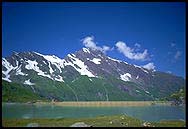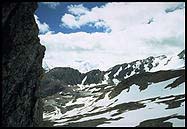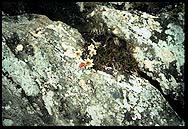 Sport climbing
at
Kitzsteinhorn Sport climbing
at
Kitzsteinhorn
August 3, 1997
Kitzsteinhorn,
3202 m, contains one
of the largest
collections of high altitude ski tracks in Austria.
The mountain is located in Kaprun,
south Salzburg,
at the northern edge of the Großglocknergruppe. It houses a large
number of ski lifts, an Alpincenter, and a weather station which
transmits
live video via the Salzburg cable-TV system. In addition, the mountain
is site to a collection of short (< 65 mH) but interesting alpine
sport
routes ranging in difficulty from III- to VIII (5.4 to 5.11d).
The day started late; we
were out of the
house
by
10:00 or so, and drove to Kaprun (15 km south of Zell am See). In
Kaprun
(786 m) we followed the main road across town up to the Talstation (911
m) of the Gletscherbahn Kaprun II. The Gletscherbahn is a 30°
inclined
train which drives through a tunnel into the Bergstation Alpincenter
Kaprun
(2452 m) in about 10 min., at a cost of ÖS 200 (you get a small
discount
if you are an Alpenverein member). At the Talstation we found excellent
parking but the lift was packed and we had to stand in the inclined
compartment
-- a bit awkward with all the skis, snow boards, and ski poles floating
around.
 The
Alpincenter is a building about the size of the average medium-size
supermarket
and accomodates the end of the lift, stores, a restaurant, and
bathrooms.
Attention should be paid to the departure time of the last train
(16:30)
given that you will have to bivvi or walk down the mountain if you miss
it. The
Alpincenter is a building about the size of the average medium-size
supermarket
and accomodates the end of the lift, stores, a restaurant, and
bathrooms.
Attention should be paid to the departure time of the last train
(16:30)
given that you will have to bivvi or walk down the mountain if you miss
it.
Out
of
the Alpincenter,
turn right and follow route Nr. 719 to the
north.
The walk takes you through rubble and small easy snow fields. Continue
on Nr. 719 following the painted rock markers (Austrian flags) and the
signs that are posted along the way. When you get to the Zauberwand
(first
big self standing chunk of rock), turn left in the general direction of
the Rettenwand (2739 m) which is the big rock on the left with the
cross
at the summit.
The
first rock problem
of the day was located at the
Grünsteinfindling
(2511 m)-- some 15-20 min. away from the Alpincenter. On the day that
we
were there, only one other party shared the entire area with us and
they
were fairly far away learning basic rope skills over the Zauberwand. We
scrambled up the north wall of the Grünsteinfindling to check the
anchors, which although new, turned out to consist of only one bolt.
The
Grünsteinfindling is a small rock and on the southwest wall, the
routes
are only 10 mH. We decided on climbing route #15, Ho-ruck!
which
is a short series of overhanging shelves with 3 bolts at the grade of
6-
(5.8). The climb seemed easy for its grade and it encouraged us to
continue
climbing.
Next
we
moved to the
Grüne Rettenwand (2640 m) which is located
some 25 m northwest from the Grünsteinfindling, and right of the
Rettenwand
(2739 m). There, we decided to climb route #9, Direkte
Edelweiß
which is a two pitch route rated grade 5 (5.7). I should mention that
in
the Kitzsteinhorn area, the routes are very clearly marked with green
circles
about 1.5 in diameter and yellow numbers at the base.
 The
first pitch of Direkte Edelweiß was easy face climbing on smooth
rock. Actually, the pitch would had been totally uneventful if it was
not
for the Edelweiß. This flower, which is the Austrian national
flower,
only grows in very remote rock faces at high altitudes. In fact, the
flower
is so rare, that before this day Monika had never seen one in the wild.
We could not believe it; the route was completely cover by the rare
flower
which grew here like a common weed. I continue the climbing paying
close
attention to not damage the flowers with the rope. The
first pitch of Direkte Edelweiß was easy face climbing on smooth
rock. Actually, the pitch would had been totally uneventful if it was
not
for the Edelweiß. This flower, which is the Austrian national
flower,
only grows in very remote rock faces at high altitudes. In fact, the
flower
is so rare, that before this day Monika had never seen one in the wild.
We could not believe it; the route was completely cover by the rare
flower
which grew here like a common weed. I continue the climbing paying
close
attention to not damage the flowers with the rope.
The
belay was good
consisting of two new 1/2 bolts. Climbing off the
belay you have the choice of three routes: #9, #10 Edelweiß or
#11 Geiernase. I intended to finish on #9 but confusion drove
me
into #11 which is grade 6- (5.8). The first moves out of the belay are
awkward; you climb through a chimney directly over a spike. If you fall
you will be impaled. The rest of the route follows the arete, giving
you
a great view of route #18 Gletscherschauckel - grade 6+, A1
(5.10a,
A1) which is probably the most aesthetic route in the Grüne
Rettenwand.
On
top
of Geiernase the
belay was good and the view was incredible.
From this advantage point you can see the entire Kitzsteinhorn area
(ski
lifts, Alpincenter, etc.), the Lakar Scharte (2488 m) which is the main
mountain pass into the Granatspitzgruppe in this area, and Großes
Wiesbachhorn (3570 m) which was the intended objective latter in the
week.
I was on the look-out for a view of the Kaindlgrat (the way up
Großes
Wiesbachhorn), but as it was going to be the case for the next four
weeks,
Großes Wiesbachhorn remained engulfed in weather after 9:00.
The
scramble off the
Grüne Rettenwand was a bit intimidating
and
exposed. The ground is full of loose rocks that once belonged to the
big
rock above. The holes of the marmots don't help either, so we turned
away
from the Rettenwand into a snow field that looked more friendly. Boy!
what
a mistake. The snow turned to be loose, wet, and at about 45°.
Without
ice axes and with a nasty rock field at the end of the snow field, we
decided
to go back to the rock band. About half way down, we reentered he the
snow
field and glissaded our way down to the bottom of the talus. Time was
short
so we decided to scrap our plans for a quick scramble up to Rettenwand,
and headed back to the Alpincenter.
All
and
all,
Kitzsteinhorn is a nice area for alpine-sport climbing
but it would not be my favorite spot even if I was a local. The ÖS
200 charge for the lift is a bit too expensive for just two pitch
routes.
However, the view, and the two stolen Edelweiß, made our day-trip
worth the price.
 Pedro I. Espina,©
1997 Pedro I. Espina,©
1997
|
 Pedro I. Espina,©
1997
Pedro I. Espina,©
1997  Pedro I. Espina,©
1997
Pedro I. Espina,©
1997